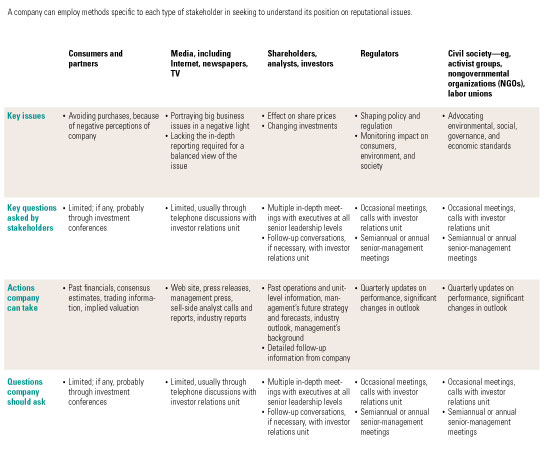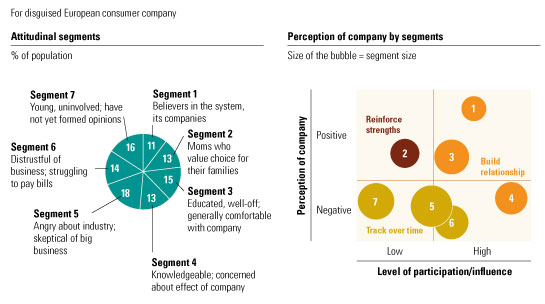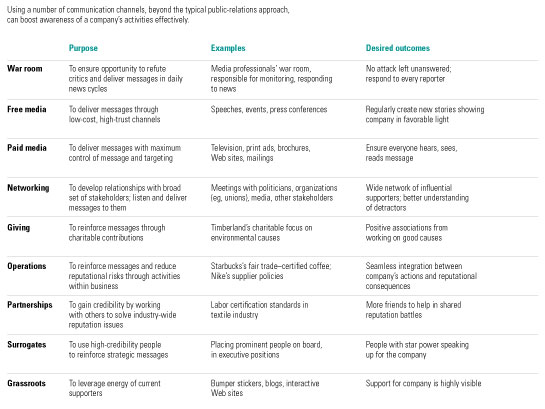As governments respond to the financial crisis and its reverberations in the real economy, a company’s reputation has begun to matter more now than it has in decades. Companies and industries with reputation problems are more likely to incur the wrath of legislators, regulators, and the public. What’s more, the credibility of the private sector will influence its ability to weigh in on contentious issues, such as protectionism, that have serious implications for the global economy’s future.
Senior executives are acutely aware of how serious today’s reputational challenge is. Most recognize the perception that some companies in certain sectors (particularly financial services) have violated their social contract with consumers, shareholders, regulators, and taxpayers. They also know that this perception seems to have spilled over to business more broadly. In a March 2009 McKinsey Quarterly survey of senior executives around the world, 85 and 72 percent of them, respectively, said that public trust in business and commitment to free markets had deteriorated.1 According to the 2009 Edelman Trust Barometer, those executives are reading the public mind correctly: 62 percent of respondents, across 20 countries, say that they “trust corporations less now than they did a year ago.”
The breadth and depth of today’s reputational challenge is a consequence not just of the speed, severity, and unexpectedness of recent economic events but also of underlying shifts in the reputation environment that have been under way for some time. Those changes include the growing importance of Web-based participatory media, the increasing significance of nongovernmental organizations (NGOs) and other third parties, and declining trust in advertising. Together, these forces are promoting wider, faster scrutiny of companies and rendering traditional public-relations tools less effective in addressing reputational challenges.
Now more than ever, it will be action—not spin—that builds strong reputations. Organizations need to enhance their listening skills so that they are sufficiently aware of emerging issues; to reinvigorate their understanding of, and relationships with, critical stakeholders; and to go beyond traditional PR by activating a network of supporters who can influence key constituencies. Doing so effectively means stepping up both the sophistication and the internal coordination of reputation efforts. Some companies, for example, not only use cutting-edge attitudinal-segmentation techniques to better understand the concerns of stakeholders but also mobilize cross-functional teams to gather intelligence and respond quickly to far-flung reputational threats.
One key to cutting through organizational barriers that might impede such efforts is committed senior leadership, including leadership from CEOs, who have an opportunity in today’s charged environment to differentiate their companies by demonstrating real statesmanship. The stakes demand it; an energized public will expect nothing else. At a moment when capitalism seems flat on its back, CEOs have an obligation to bolster the reputations of their companies and of free markets.
A rapidly evolving reputation environment
The financial crisis has underscored just how ill-equipped companies can be to deal with two important changes in the reputation environment. First, the influence of indirect stakeholders—such as NGOs, community activists, and online networks—has grown enormously. The number of NGOs accredited by the United Nations, for instance, has grown to more than 4,000, from less than 1,000 in the early 1980s. These proliferating indirect stakeholders have tasked business with a broader set of expectations, such as making globalization more humane and combating climate change, obesity, human-rights abuses, or HIV.
Second, the proliferation of media technologies and outlets, along with the emergence of new Web-based platforms, has given individuals and organizations new tools they use to subject companies to greater and faster scrutiny. This communications revolution also means that certain issues (such as poor labor conditions) that might be acceptable in one region can be picked up by “citizen journalists” or bloggers and generate outrage in another.
As a result, what formerly were operational risks resulting from failed or inadequate processes, people, or systems now often manifest themselves as reputational risks whose costs far exceed those of the original missteps. In banking, for example, data privacy has become a reputational issue. In pharmaceutical clinical trials, Merck’s experience with Vioxx showed that anything less than full transparency can lead to disaster. And as risk-management problems in the financial sector have generated astronomical losses that taxpayers are helping bear, it’s little wonder that the reputational fallout has been enormous.
An outmoded approach to reputation management
In this dispersed and multifaceted environment, companies must collect information about reputational threats across the organization, analyze that information in sophisticated ways, and address problems by taking action to mitigate them. That can involve developing alliances with new kinds of partners and coordinating responses from a number of parties, including governments, civil-society groups, and consumers. All this requires significant coordination and an ability to act quickly.
Many companies, though, rely primarily on small, central corporate-affairs departments that can’t monitor or examine diverse reputational threats with sufficient sophistication. Moreover, traditional PR spin can’t deal with many NGO concerns, which must often be addressed by changing business operations and conducting two-way conversations. Managers of business units have a better position for spotting potential challenges but often fail to recognize their reputational significance. Internal communication about them may be inhibited by the absence of consistent methodologies for tracking and quantifying reputational risk. Accountability for managing problems is often blurred.
As a result, responses to reputational issues can be short term, ad hoc, and defensive—a poor combination today given the intensity of public concern. And therein lies a problem that companies must solve quickly: even as reputational challenges boost the importance of good PR, companies will struggle if they rely on PR alone, with little insight into the root causes of or the facts behind their reputational problems.
A better, more integrated response
A logical starting point for companies seeking to raise their game is to put in place an effective early-warning system to make executives aware of reputational problems quickly. In our experience, most companies are quite good at tracking press mentions, and many are beginning to monitor the multitude of Web-based voices and NGOs, whose power is beginning to rival the mainstream media’s. However, doing these things effectively, while an important prerequisite for stepping up engagement with stakeholders, isn’t the toughest task facing organizations.
Far more of a challenge is preparing to meet serious reputational threats, whose potential frequency and cost have risen dramatically given the greater likelihood that stakeholders—including regulators and legislators—will lash out in an atmosphere that’s become less hospitable to business. These threats might take a variety of forms: issues related to a company’s business performance, like those that financial companies have recently experienced (see sidebar, “Assuming responsibility”); unexpected shocks along the lines of Johnson & Johnson’s Tylenol scare, more than two decades ago; opposition to business moves, such as expanding operations; or long-standing, sector-specific issues, for instance climate change (industrials and oil and gas), obesity (the food and beverage industry), hidden fees (telecom providers), “e-waste” (high tech), and worker safety (mining).
To prepare for and respond to these threats, our experience suggests that companies should emphasize three priorities. First, they need to assemble enough facts—most important, perhaps, a rich understanding of key stakeholders, including consumers—and not only the product preferences but also the political attitudes of consumer groups. Second, companies should focus on the actions that matter most to stakeholders, something that may call for an exaggerated degree of transparency about corporate priorities or operations. Third, they must try to influence stakeholders through techniques that go beyond traditional PR approaches, with an emphasis on two-way dialogue. Underlying these priorities is a willingness to participate in the public debate more actively than many companies have in the past. Instead of allowing single-issue interest groups to control the conversation, companies should insist on a more complete dialogue that raises awareness of the difficult trade-offs they face.
Understanding stakeholders and their concerns
Companies should first develop a deeper understanding of the reputational issues that matter to their stakeholders and of the degree to which their products, services, operations, supply chains, and other activities affect those issues. A company trying to improve its environmental reputation, for example, needs to document, catalog, and assess its sustainability efforts and then to benchmark them against those of its competitors and industry standards. The facts should be presented objectively and, if possible, quantitatively—for example, the amount of carbon emitted or water used. Quantitative measurements promote effective comparisons and help companies avoid ignoring potential issues or performance gaps.
Such an analysis may lead a company to conclude that it has a good story that should be told more vigorously—or that it should refrain from doing so until it takes real action. The analysis also is the starting point for an objective quantification of reputational risks. The company can prioritize them and the measures needed to keep them at bay by assessing the probability and financial cost of potential reputational events, such as consumer boycotts or the forced closure of operations.
Reputations are built on perceptions, however, so issue analysis isn’t enough. Companies must also know if they are meeting the expectations of key stakeholders—those in the best position to influence sales and growth. To identify these centers of influence, companies should cast a wide net, scrutinizing not just traditional stakeholders (consumers, employees, shareholders, and regulators) but also indirect ones, such as NGOs and the media, that help shape attitudes. Even for companies that don’t deal directly with consumers, it’s important to understand public opinion. People have unprecedented access to information now and may therefore concern themselves with a surprisingly wide array of issues, potentially providing the impetus for regulatory or legislative action.
Each kind of stakeholder has unique perceptions and concerns. Shareholders might ask if reputational issues will affect a company’s long-term growth prospects. Regulators could worry that the public thinks they should curb the company. The media might wonder if it could be an example of how business exploits society. There are different ways of identifying the perceptions of each kind of stakeholder and their root causes (Exhibit 1). A detailed press analysis can help companies to understand the positions of columnists and editors on key issues. Interviews with regulators can clarify their concerns. Focus groups and market research are important for understanding consumers and the wider public.
Understanding the stakeholders

If consumer research is required, companies must understand that an analysis of how different consumers feel about them differs from typical segmentations: one for reputation management resembles a dissection of voters in a political campaign rather than a parsing of customers who prefer different types of products or services. There might, for example, be a group of consumers who care deeply about social issues and will weigh in aggressively on regulatory ones affecting a company’s operations. Others, such as swing voters, might be undecided about whether, or how, to become involved. Some could be uninterested and unlikely to take action. Still others may be so anti- or probusiness that their positions are set in stone. One consumer company facing regulatory challenges used this type of “social attitudinal” segmentation to analyze consumers (Exhibit 2). After identifying people who were both influential and open-minded, the company focused on addressing their needs, and the public’s attitudes toward it improved.
Whom to target

Transparency and action
Reputations are built on a foundation not only of communications but also of deeds: stakeholders can see through PR that isn’t supported by real and consistent business activity. Consumers, our research indicates, feel that companies rely too much on lobbying and PR unsupported by action. They also fault companies for not sharing enough information about critical business issues—for manufacturers, say, the content of their products, their manufacturing processes, and their treatment of production employees. Transparency in such matters is crucial. Sometimes it highlights a mismatch between consumer expectations and a company’s performance and therefore calls for action. In other cases, transparency can convince key stakeholders that the company is headed in the right direction.
After the director of the US Food and Drug Administration voiced reservations about the side effects of the high-cholesterol treatment Crestor, for example, AstraZeneca not only placed ads in the national press to present its case but also took the unusual step of providing raw clinical-trial data on its Web site, allowing completely independent researchers to draw their own conclusions. This was a high-risk strategy, since it’s always possible to draw different statistical inferences from the same data. But the strategy reestablished public trust and stabilized Crestor’s market share.
Consider also the efforts of the US plastics industry to overcome a consumer and regulatory backlash, in the late 1980s, over plastic packaging’s environmental impact. The CEOs of leading companies joined forces to reframe the public debate not just through an award-winning ad campaign illustrating positive applications of plastics (in child safety, for example) but also by committing the industry to recycling and thus to solving environmental problems. The industry could do so credibly because it undertook real actions, such as spending $1.2 billion on recycling research and developing a standardized plastics-coding system.
Such actions need not take place only in response to reputational concerns; at other times, they help build goodwill that may provide some degree of cover against future bad news. A willingness to tackle climate change has helped companies like Toyota Motor and GE, for example, build strong reputations that are holding up better than those of many other major automotive and financial-services players. Sometimes, reputation-oriented actions may even have a direct impact on sales. In 2008, for instance, Best Buy began inviting customers to bring their old electronics into its stores for recycling. The program has not only generated positive press and helped position the company as an environmental leader but is also increasing foot traffic in stores.
Engaging a broad group of influencers
Formal marketing and PR do play an important role in managing the reputation of a company, but when it responds to serious threats it must use many other means of spreading positive messages about its activities quickly (Exhibit 3). In general, credible third parties speaking for the company can boost its reputation more effectively than its own PR or marketing department. Leveraging existing grassroots support—through blogs, bumper stickers, and interactive Web sites, for example—is one method. Another is to have people with high standing reinforce key strategic messages. Partnerships between the company and NGOs can be important not only because of their credibility but also because they can alert it to performance gaps early in the game. A network of positive relationships with credible third parties (such as journalists and NGOs) can also help the company get out its side of the story when crises do hit.
One company worried about what it saw as the dangerous inaccuracy of its portrayal in the press targeted opinion leaders with concise facts to dispel misunderstandings and gave regulators a scientific paper outlining the possible negative consequences of proposed regulations. A broader communication program describing recent and forthcoming changes in the company’s business practices was released to the general public. This approach was effective, but even more nuanced forms of impact are possible: influencing specific bloggers, using company blogs to start conversations with consumers (a tactic Cisco, HP, and Intel, among others, use), and reaching scientists through research discussion boards.
Increasingly, two-way dialogue is critical. Consider, for example, Chevron’s “Will you join us?” campaign, which addresses many of the oil industry’s most difficult questions, such as the developing world’s energy needs, the role of renewables, environmental protection, and the problems that will get worse if we go on using oil as we do now. The campaign not only embodies a new level of openness about the industry’s challenges but also asks the public to join the conversation on a Web site with a moderated discussion board and interactive tools providing information about conserving energy.
Tactics for influencing reputations

In this more complex world of influence strategy, no single kind of approach is likely to be sufficient to deal with fast-moving situations. Companies must instead initiate a multidisciplinary, cross-functional effort that can quickly identify reputational issues and plant responses in broader strategy, operations, and communications. The groups involved might include regulatory affairs, the general counsel, PR or corporate communications, marketing, corporate social responsibility, and investor relations.
To achieve the necessary coordination, a senior executive should be accountable for such efforts. A strong understanding of customers and marketing might make the CMO appropriate to play this role.2 But it’s the CEO who must lead a company’s overall reputation strategy, ideally with the support of a board committee focused on it. This may seem like a lot of firepower, but in today’s climate, with reputational issues threatening both shareholders and a company’s ability to achieve broader goals, that degree of high-level attention and integration is essential.
